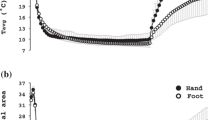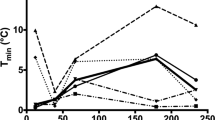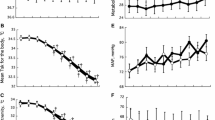Summary
Eight subjects, who were indoor workers and not habitually exposed to cold, spent 53 days in Antarctica. They did mainly geological field work often requiring the use of bare hands. The effects of the expedition on responses to a whole body cold exposure test, a finger blood flow test and a cold pressor test were studied. After the expedition, during whole-body cooling the time for the onset of shivering was delayed by 36 min (P<0.001) and forearm and thigh temperatures were 1.5°C higher (P<0.05) at the end of exposure. During local cooling of the finger with 10°C perfusion, finger vascular resistance was 14.9 (SEM 6.6) mmHg · ml−1 · min · 100 ml (P<0.05) lower and finger temperature 3.9 (SEM 0.8) °C higher (P< 0.01). However, the decrease in rectal temperature during wholebody cooling was unaltered and the response to a cold pressor test was unchanged. The data would indicate that partial acclimatization to cold had been developed. Changes in forearm temperature were correlated with the duration of cold exposure of the hands (P < 0.05) and finger vascular resistance and finger temperature were correlated with responses to cooling before the expedition (P<0.001 and P<0.01, respectively). Because the ambient temperature was not clearly lower in Antarctica in comparison to Finland, the reason for the changes developed seems to be the increased exposure to the outdoor climate in Antarctica.
Similar content being viewed by others
References
Acheson KJ, Campbell IT, Edholm OG, Miller DS, Stock MJ (1980) The measurement of daily energy expenditure - an evaluation of some techniques. Am J Clin Nutr 33:1155–1164
Bittel JHM (1987) Heat debt as an index for cold adaptation in men. J Appl Physiol 62:1627–1634
Bittel J, Livecchi-Gonnot GH, Hanniquet AM, Poulain C, Etienne JL (1989) Thermal changes observed before and after J. L. Etienne's journey to the North Pole. Is central nervous system temperature preserved in hypothermia? Eur J Appl Physiol 58:646–651
Brown GM, Page J (1952) The effect of chronic exposure to cold on temperature and blood flow of the hand. J Appl Physiol 5:221–227
Budd GM (1966) Skin temperature, thermal comfort, sweating, clothing and activity of men sledging in Antarctica. J Physiol 186:210–215
Durnin JVGA, Womersley J (1974) Body fat assessed from total body density and its estimation from skinfold thickness: measurements on 481 men and women aged from 16 to 72 years. Br J Nutr 32:77–97
Edholm OG (1966) The assessment of habitual activity. In: Evang K, Lange Andersen K (eds) Physical activity in health and disease. Universitetsbolaget, Oslo
Gemne G, Pyykkö I, Starck J, Ilmarinen R (1986) Circulatory reaction to heat and cold in vibration-induced white finger with and without sympathetic blockade — an experimental study. Scand J Work Environ Health 12:371–377
Hellström B, Lange Andersen K (1960) Heat output in the cold from hands of arctic fishermen. J Appl Physiol 15:771–775
International Standards Organisation (ISO) (1989) Assessment of the influence of the thermal environment using subjective judgement scales. ISO/DP 10551
Kalkwarf HJ, Haas JD, Belko AZ, Roach RC, Roe DA (1989) Accuracy of heart-rate monitoring and activity diaries for estimating energy expenditure. Am J Clin Nutr 49:37–43
Krog J, Folkow B, Fox RH, Lange Andersen K (1960) Hand circulation in the cold of Lapps and north Norwegian fishermen. J Appl Physiol 15:654–658
Lange Andersen K, Masironi R, Rutenfranz J, Seliger V, Degré S, Trygg K, Orgim M (1978) Habitual physical activity and health. World Health Organisation, WHO Regional Publications, European Series No. 6. Copenhagen
Leppäluoto J, Laapio H, Hassi J (1991) Serum thyroid hormone, TSH, cortisol and electrolyte concentrations in the members of the Finnish Antarctic expedition in 1989–1990. Ministry of Trade and Industry, report no. 1, pp 121–123
Livingstone SD (1976) Changes in cold-induced vasodilatation during Arctic exercise. J Appl Physiol 40:455–457
Livingstone SD, Nolan RW, Keefe AA (1990) The effects of a 90 day polar ski expedition on cold acclimatization. The 8th International Congress on Circumpolar Health, Yukon, Canada, May 20–25, 1990. University of Manitoba Press, Winnipeg, Manitoba
Nelms JD, Soper DJG (1962) Cold vasodilatation and cold acclimatization in the hands of British fish filleters. J Appl Physiol 17:444–448
Rivolier J, Goldsmith R, Lugg DJ, Taylor AJW (1988) Man in the Antarctic. Taylor and Francis, London, pp 105–147
Savourey G, Vallerand AL, Bittel JHM (1992) General and local cold adaptation after a ski journey in a severe arctic environment. Eur J Appl Physiol 64:99–105
Strempel H (1976) Adaptive Modifikationen des Kälteschmerzes. Eur J Appl Physiol 36:19–25
Wyndham CH, Plotkin R, Munro A (1964) Physiological reactions to cold of men in the Antarctic. J Appl Physiol 19:593–597
Author information
Authors and Affiliations
Rights and permissions
About this article
Cite this article
Rintamäki, H., Hassi, J., Smolander, J. et al. Responses to whole body and finger cooling before and after an Antarctic expedition. Eur J Appl Physiol 67, 380–384 (1993). https://doi.org/10.1007/BF00357639
Accepted:
Issue Date:
DOI: https://doi.org/10.1007/BF00357639




